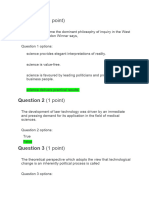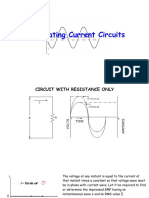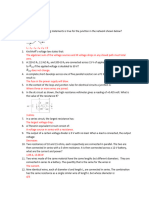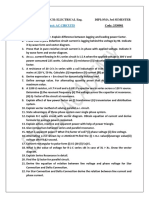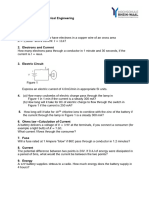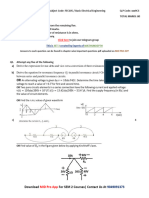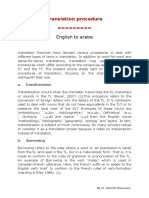Problem Set 3 Student
Problem Set 3 Student
Uploaded by
Leo Dominick MagpantayCopyright:
Available Formats
Problem Set 3 Student
Problem Set 3 Student
Uploaded by
Leo Dominick MagpantayOriginal Description:
Original Title
Copyright
Available Formats
Share this document
Did you find this document useful?
Is this content inappropriate?
Copyright:
Available Formats
Problem Set 3 Student
Problem Set 3 Student
Uploaded by
Leo Dominick MagpantayCopyright:
Available Formats
College of Engineering, Architecture and Fine Arts
Electrical and Computer Engineering Department
PROBLEM SET NO. 3
Direction: Solve the following problems until you derive what is/are asked in the problem. Show the complete
solution. Box your final answer/s. Use short bond paper (with visible margin 1x1in) and engineering lettering for
writing. Provide a cover page for your final paper.
1. An alternating current varying sinusoidally with a frequency of 5o Hz has an RMS value of 20 A. Write
down the equation for the instantaneous value and find this value (a) 0.0025 second (b) 0.0125 second
after passing through a positive maximum value. At what time, measure from a positive maximum value,
will the instantaneous current be 14.14 A?
2. An alternating current of frequency 50 Hz has a maximum value of 100 A. Calculate (a) its value 1/600
second after the instant the current is zero and its value decreasing thereafter (b) how many seconds
after the instant the current is zero (increasing thereafter wards) will the current attain the value of 86.6A?
3. Plot the sinusoidal wave of the following equations of voltages:
(a) v = 400 sin(2πft + 600)
(b) v = 50 sin(2πft - 900)
(c) v = 190 cos(2πft + 1200)
(d) v = 270 sin(2πft + π/4)
(e) v = 350 cos(2πft - π/8)
(f) v = 90 cos(2πft - 550)
4. Plot the sinusoidal wave of the following equations of current:
(a) i = 90 sin(2πft + 700)
(b) i = 150 cos(2πft - 15000)
(c) i = 160 sin(2πft + 200)
(d) i = 370 cos(2πft - π/2)
(e) i = 20 cos(2πft + 3π/2)
(f) i = 30 cos(2πft + 350)
5. The impedance of the parallel RLC circuit shown is given by
Prepared By: Engr. Jayson J. Dela Roca, RME, REE
Page 1 of 6
6. Determine the impedance for the circuit.
7. A circuit consists of a current source, i=0.030sin500t, in parallel with L=20mH, C = 50 mF, and R = 25
ohms. a. Determine the voltage V across the circuit. b. Solve for the power factor of the circuit. c. Calculate
the average power dissipated by the circuit and verify that this is equal to the power delivered by the
source. d. Use Ohm’s law to find the phasor quantities, IR, IL, and IC.
8. Find the total impedance for the network shown:
9. Find the equivalent impedance of the network:
Prepared By: Engr. Jayson J. Dela Roca, RME, REE
Page 2 of 6
10. Consider the circuit:
a. Find Zt.
b. Determine the voltages VR and VL using the voltage divider rule.
c. Verify Kirchhoff’s voltage law around the closed loop.
11. Determine the impedance Z which must be within the indicated block of figure if the total impedance of
the network is 13 ∠22.62° ohms.
12. Consider the network of figure
a. Find Zt.
b. Use Ohm’s law to determine I,VR, and VC
Prepared By: Engr. Jayson J. Dela Roca, RME, REE
Page 3 of 6
13. Find the equivalent impedance of the network of Figure
14. Calculate the current in each of the branches in the network of figure:
15. Determine the total impedance of the network of figure. Express the impedance in both polar form and
rectangular form.
16. Consider the circuit of figure
Prepared By: Engr. Jayson J. Dela Roca, RME, REE
Page 4 of 6
a. Find Zt.
b. Determine the currents I1, I2, and I3.
c. Calculate the total power provided by the voltage source.
d. Determine the average powers P1, P2, and P3 dissipated by each of the impedances. Verify that the
average power delivered to the circuit is the same as the power dissipated by the impedances
17. Given the circuit of figure
a. Determine the current I and the voltage V R.
18. Two impedances Z1 = 15 + j20 and Z2 = 5 – jXc are connected in parallel. Solve for the value of X c so
that the total current drawn by the combination will be in phase with any supply voltage.
19. A non-inductive resistor R is connected in parallel with an inductive reactance of 10 ohms. The
combination is then connected in series with a capacitive reactance of 5 ohms. Solve for R at which the
power factor of the given circuit would be unity.
20. A 300-ohm inductive reactance is connected across a series combination of a resistor R and a capacitive
reactance Xc. Solve for R if the equivalent impedance of the combination is a pure resistance of 100
ohms.
21. A 10-ohms resistor is connected in parallel with an inductive reactance of 10 ohms. The combination is
then connected in series with a capacitive reactance of 5 ohms. Solve for R at which the power factor of
the given circuit would be unity.
22. A resistance R is connected in parallel in parallel with a variable inductive reactance XL. The combination
is connected in series with impedance of 5 – j2 ohms. Solve for R, such so there is only one condition of
resonance as XL as varied.
23. Given the circuit of figure determine the current I and the voltage V R.
Prepared By: Engr. Jayson J. Dela Roca, RME, REE
Page 5 of 6
24. A wye connected load has a 5<200 ohm impedance per phase and is connected across a 120 V three
phase source. Calculate the line current.
25. A balanced delta connected load having impedance per phase of 20<36.87 0 ohms is supplied from a
balanced 3-phase, 240 V source. Determine the real power.
26. A system consisting of three equal resistors connected in star is fed from a three-phase supply. By how
much is the power reduced if one of the three resistors is disconnected?
27. A balanced three phase load is wye connected and has an impedance Z p = 4 – j3 ohms per phase. Find
the line current if this load is connected across a 220 V three phase source.
28. Three resistors 10, 15, and 30 ohmic values are connected in wye configuration to a balanced 208 volt
three phase supply. Calculate the total power of the system.
29. Two parallel connected loads A and B are supplied by a 440 V, 3 phase, 60 Hz generator. Load A draws
an apparent power of 100 kVA at 0.80 lagging and load B draws an apparent power of 70 kVA at unity
pf. Determine the feeder current.
30. A three phase motor takes 10 kVA at 0.6 pf lagging from a source of 230 V. It is in parallel with a balanced
delta load having 16 ohms resistance and 12 ohms capacitive reactance in series in each phase.
Determine the total power factor.
Prepared By: Engr. Jayson J. Dela Roca, RME, REE
Page 6 of 6
You might also like
- Question 1 (1 Point)Document44 pagesQuestion 1 (1 Point)milanchabhadiya288No ratings yet
- Icsst Nfpa-1001 Ff.i Reviewer - MarkedDocument40 pagesIcsst Nfpa-1001 Ff.i Reviewer - MarkedTinashe chikwanhaNo ratings yet
- ReviewerDocument36 pagesReviewerKaye BacomoNo ratings yet
- Morte D'arthurDocument5 pagesMorte D'arthuremilyjaneboyle100% (3)
- EEE Assignment1 AC Fundamental1 2011-12Document8 pagesEEE Assignment1 AC Fundamental1 2011-12Arpit ShahNo ratings yet
- Circuits 22Document4 pagesCircuits 22Davis Spat TambongNo ratings yet
- Question Bank (ECE)Document7 pagesQuestion Bank (ECE)Manav JainNo ratings yet
- Tutorial-2 EE AC, 1-Phase PartDocument3 pagesTutorial-2 EE AC, 1-Phase PartDebendra Bahadur RautNo ratings yet
- AC ws-1Document6 pagesAC ws-1sowmiasojanNo ratings yet
- Problem SetDocument3 pagesProblem SetAJ REPECILONo ratings yet
- CH 7 Ac Worksheet 2022Document5 pagesCH 7 Ac Worksheet 2022Hamad FarooqueNo ratings yet
- Electric Circuit AnalysisDocument12 pagesElectric Circuit AnalysisMATHANKUMAR.SNo ratings yet
- Ac CircuitsDocument3 pagesAc CircuitsJeremy HensleyNo ratings yet
- Diploma Board Examination - December 2020Document2 pagesDiploma Board Examination - December 2020SabariPandiyanNo ratings yet
- EEE SyllabusDocument11 pagesEEE Syllabussamarpit_anandNo ratings yet
- Ee6201 CT U1 5 QBDocument10 pagesEe6201 CT U1 5 QBsakilakumaresanNo ratings yet
- Question Bank: Basic Electrical EngineeringDocument5 pagesQuestion Bank: Basic Electrical Engineeringdeepakrajput90501No ratings yet
- Question Bank With Answers: BE 8253 - Basic Electrical, Electronics and Instrumentation EngineeringDocument93 pagesQuestion Bank With Answers: BE 8253 - Basic Electrical, Electronics and Instrumentation EngineeringRajeshNo ratings yet
- Part B & Part C Questions - Unit Wise: Ec8251 Circuit AnalysisDocument4 pagesPart B & Part C Questions - Unit Wise: Ec8251 Circuit AnalysisAnonymous Ndsvh2soNo ratings yet
- Bee - I GT-2Document2 pagesBee - I GT-2Kumara SwamyNo ratings yet
- Problems 33Document12 pagesProblems 33Daniyar MuratovNo ratings yet
- Elements of Electrical Engineering: 2013-14 (1 Sem) Question Bank From My PortionsDocument7 pagesElements of Electrical Engineering: 2013-14 (1 Sem) Question Bank From My PortionsWarren RiveraNo ratings yet
- ELECTRICAL CIRCUITS SyllabusDocument8 pagesELECTRICAL CIRCUITS SyllabusShareef KhanNo ratings yet
- Ac Circuits Part IIIDocument26 pagesAc Circuits Part IIIblehNo ratings yet
- Problem Set in ELE 001Document8 pagesProblem Set in ELE 001Patrick GarciaNo ratings yet
- Practice Assignment - EE - 221226 - 130544Document10 pagesPractice Assignment - EE - 221226 - 130544aps.apssingh9No ratings yet
- Module2 Qbank 2023-24Document3 pagesModule2 Qbank 2023-24Aqsa MohammadiNo ratings yet
- Bee Theory and Nuerical Question BankDocument7 pagesBee Theory and Nuerical Question BankC1 314 Krishna GavaneNo ratings yet
- Electrical Question BankDocument4 pagesElectrical Question BankAmar Wali0% (1)
- Act. Module 4 - Resonance, Bandwidth, Non-Sinusoidal WaveformDocument6 pagesAct. Module 4 - Resonance, Bandwidth, Non-Sinusoidal WaveformSherwin PagpaguitanNo ratings yet
- Serway 6 e Problems 33Document12 pagesSerway 6 e Problems 33Siva KumarNo ratings yet
- QuizzesDocument3 pagesQuizzesFrizz CruzNo ratings yet
- Ac FundementalDocument4 pagesAc FundementalThe legend TivrakashyapNo ratings yet
- Unit-2 QuestionsDocument3 pagesUnit-2 Questionsabhioptimus00No ratings yet
- EEE (ELT-112 & - 110) /EEE (ECT-110) (For BE-CE, PE, CHEM, BIO-TECH, CSE, ECE)Document3 pagesEEE (ELT-112 & - 110) /EEE (ECT-110) (For BE-CE, PE, CHEM, BIO-TECH, CSE, ECE)Santosh KumarNo ratings yet
- EEE CT1 Sample QuestionsDocument6 pagesEEE CT1 Sample QuestionsSiddhant KaushikNo ratings yet
- Emi and Ac AssignmentDocument5 pagesEmi and Ac AssignmentMohammed AmmaarNo ratings yet
- Questions Chap 7 Alternating Current - 77504 - 2023 - 01 - 14 - 22 - 53Document4 pagesQuestions Chap 7 Alternating Current - 77504 - 2023 - 01 - 14 - 22 - 53Abhay ThakurNo ratings yet
- MET-2.2 QuestionsDocument20 pagesMET-2.2 QuestionsApoorv SinghNo ratings yet
- Basic Electrical Engineering Question Bank-21EEE15ADocument18 pagesBasic Electrical Engineering Question Bank-21EEE15AG46Anand P KNo ratings yet
- AC Circuits Note BookDocument44 pagesAC Circuits Note Bookron Joshua QuirapNo ratings yet
- ES Assignment 2Document5 pagesES Assignment 2spectrum1302No ratings yet
- CT Important QuestionsDocument14 pagesCT Important QuestionsJacob JayaseelanNo ratings yet
- Review Exam ELEC Questions and AnswersDocument27 pagesReview Exam ELEC Questions and AnswersheelchristianNo ratings yet
- BEEE Assignment 3Document3 pagesBEEE Assignment 3Tharun BalapalaNo ratings yet
- Single Pahse Ac Additional QuestionDocument7 pagesSingle Pahse Ac Additional QuestionYuvaraj BadigerNo ratings yet
- AC Circuit DIPLOMA EE SEM 3Document2 pagesAC Circuit DIPLOMA EE SEM 3Rana HenilNo ratings yet
- Basic Electrical Engineering (BTEE-T-ES-001) - End Term Exam - 2021-2022Document3 pagesBasic Electrical Engineering (BTEE-T-ES-001) - End Term Exam - 2021-2022LAXMI NARAYAN SAHOO B.TECHNo ratings yet
- Exercise 1 CombinedDocument12 pagesExercise 1 CombinedAnonymous The HackerNo ratings yet
- ENGN 20 HomeworkDocument28 pagesENGN 20 HomeworkAhsan FarooquiNo ratings yet
- Adobe Scan 22-Oct-2024Document2 pagesAdobe Scan 22-Oct-2024Arihant SharmaNo ratings yet
- AC Numericals1Document3 pagesAC Numericals1Pavan KhetrapalNo ratings yet
- Electronic Devices and CircuitsDocument12 pagesElectronic Devices and CircuitsAnandhi SrinivasanNo ratings yet
- Mid Bee Paper Set 3Document6 pagesMid Bee Paper Set 3raghusabale1No ratings yet
- Important Questions For CBSE Class 12 Physics Chapter 7Document46 pagesImportant Questions For CBSE Class 12 Physics Chapter 7sudhanshu narvekarNo ratings yet
- Polytechnic College: Answer All QuestionsDocument2 pagesPolytechnic College: Answer All Questionsmanjuu_eeeNo ratings yet
- Assignment 7Document2 pagesAssignment 7Pavan KhetrapalNo ratings yet
- AC Circuit 1 (Single-Phase)Document2 pagesAC Circuit 1 (Single-Phase)marlon desaculaNo ratings yet
- 21498d689f43ad3001855bae328c5bbcDocument6 pages21498d689f43ad3001855bae328c5bbcmaterialstudy2400No ratings yet
- Assignment 3 - Ac CircuitDocument3 pagesAssignment 3 - Ac CircuitDiptiben GanatraNo ratings yet
- Easy(er) Electrical Principles for General Class Ham License (2019-2023)From EverandEasy(er) Electrical Principles for General Class Ham License (2019-2023)No ratings yet
- Subiecte Clasa A Ix-ADocument3 pagesSubiecte Clasa A Ix-Araluca_patrixNo ratings yet
- Wongyai, PotcharaDocument98 pagesWongyai, Potchara育宏林No ratings yet
- People v. Artoza y Katang-KatangDocument2 pagesPeople v. Artoza y Katang-Katangf919No ratings yet
- Entrepreneurship DLL 1Document4 pagesEntrepreneurship DLL 1Sheen DeeNo ratings yet
- Trans Procedures English To ArabeDocument7 pagesTrans Procedures English To Arabethe oneNo ratings yet
- Summary of The Most Important English LessonsDocument16 pagesSummary of The Most Important English Lessonskhadidja.bhNo ratings yet
- VLLT@Document9 pagesVLLT@Anonymous UiH9hwNo ratings yet
- Chapter 1 Overview and Evolution of EntrepreneurshipDocument11 pagesChapter 1 Overview and Evolution of EntrepreneurshipFara HaniNo ratings yet
- Circulationaha 117 027966 FullDocument61 pagesCirculationaha 117 027966 Fulloliver_vigoNo ratings yet
- Release Final - João GordoDocument2 pagesRelease Final - João GordoHomero JanuncioNo ratings yet
- Business Objectives: Multiple-Choice QuestionsDocument2 pagesBusiness Objectives: Multiple-Choice Questionsno dont look at meNo ratings yet
- The Impact of Humor in Advertising: A Review: Marc G. Weinberger and Charles S. GulasDocument26 pagesThe Impact of Humor in Advertising: A Review: Marc G. Weinberger and Charles S. GulasSujal RaneNo ratings yet
- Trimble Open Pit Design DatasheetDocument2 pagesTrimble Open Pit Design DatasheetPelotudoPeloteroNo ratings yet
- The Organization Man (1956) : by William H. Whyte, JRDocument5 pagesThe Organization Man (1956) : by William H. Whyte, JRMatthew PiljekNo ratings yet
- Ud Assignments BriefDocument6 pagesUd Assignments BriefReshma DanielNo ratings yet
- Inclined Plane Experiment NewestDocument3 pagesInclined Plane Experiment Newestapi-238942037No ratings yet
- PFR Reviewer MidtermsDocument10 pagesPFR Reviewer MidtermsApr CelestialNo ratings yet
- Good Thesis Statement For Organ DonationDocument7 pagesGood Thesis Statement For Organ Donationamymilleranchorage100% (2)
- Frozen StoryDocument4 pagesFrozen Storyedgar jr. suyat100% (1)
- Feb 2007 Irish Actuarial Communication PresentationDocument18 pagesFeb 2007 Irish Actuarial Communication Presentationshush10No ratings yet
- Sources of Magnetic Field: General Physics Phys. 106Document127 pagesSources of Magnetic Field: General Physics Phys. 106hwuhwuheNo ratings yet
- People Vs BalibayDocument9 pagesPeople Vs BalibayFord OsipNo ratings yet
- Bollas FreeAssociationDocument55 pagesBollas FreeAssociationFAUZI PALIS JUNIORNo ratings yet
- A. Count and Write The Number of Objects in Numerals and WordsDocument10 pagesA. Count and Write The Number of Objects in Numerals and Wordse_awinNo ratings yet
- Ultimate Guide For Descriptive English: Free E-BookDocument11 pagesUltimate Guide For Descriptive English: Free E-BookRaja ShekarNo ratings yet
- Impact of Price, and Quality On Brand Loyalty of Automobiles in PakistanDocument7 pagesImpact of Price, and Quality On Brand Loyalty of Automobiles in Pakistanrubu0000000000No ratings yet
- Chapter 1 (Cansingnment Account)Document24 pagesChapter 1 (Cansingnment Account)Bravish GowardhanNo ratings yet
